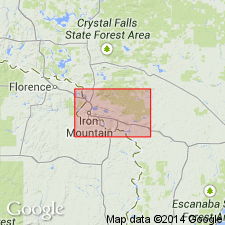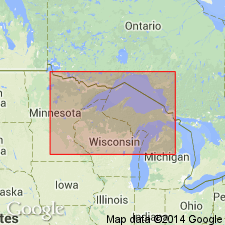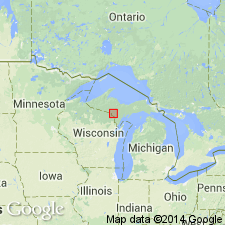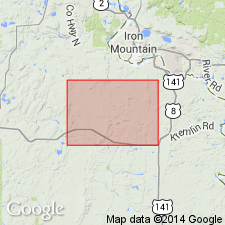
- Usage in publication:
-
- Quinnesec schists*
- Modifications:
-
- Named
- Dominant lithology:
-
- Schist
- Greenstone
- AAPG geologic province:
-
- Lake Superior region
Summary:
Quinnesec schists. Greenstone schists, gabbros, diabases, and diorites, cut by dikes of gabbro, diabase, diorite, and granite. Recognized in two areas: (1) southern area is complex of dark-green or black basic schists cut by large dikes of gabbro, diabase, and granite and by smaller dikes and veins of schistose quartz-porphyry; and (2) western area is greenstone-schists and spheroidal greenstones, locally cut by basic dikes. Assigned to Archean, and treated as oldest formation of region; schists are same as the Archean schists of Marquette district, Michigan, and Vermillion district, Minnesota.
Named from Quinnesec Falls on the Menominee River, Dickinson Co., Northern Peninsula, northwestern MI (Lake Superior region). Quinnesec Falls is on some of harder ledges of these rocks.
[GNC remark (ca. 1936, US geologic names lexicon, USGS Bull. 896, p. 1760): In 1911 (USGS Monograph 52) C.R. Van Hise and C.K. Leith assigned these schists to late upper Huronian (post-Michigamme slate).]
Source: US geologic names lexicon (USGS Bull. 896, p. 1760); supplemental information from GNU records (USGS DDS-6; Reston GNULEX).

- Usage in publication:
-
- Quinnesec greenstone*
- Modifications:
-
- Revised
- AAPG geologic province:
-
- Wisconsin arch
Summary:
Changed name of formation to Quinnesec greenstone and classified it as older than Michigamme slate. Age is pre-Cambrian (upper Huronian).
Source: US geologic names lexicon (USGS Bull. 896, p. 1760).

- Usage in publication:
-
- Quinnesec formation*
- Modifications:
-
- Revised
- Redescribed
- Areal extent
- Dominant lithology:
-
- Greenstone
- Amphibolite
- Schist
- AAPG geologic province:
-
- Lake Superior region
Summary:
Pg. 30 (table 1), 33. Quinnesec formation. Name applied to greenstone amphibolite and schist that form a belt in southernmost Dickinson County, northwestern Michigan, and adjacent parts of Wisconsin (Lake Superior region). These rocks were referred to as Quinnesec schists by Van Hise and Bayley (1900) who assigned them to the Archean and as Quinnesec greenstone by Leith, Lund, and Leith (1935) who assigned them to the middle Huronian. Recent mapping in the type area shows that rocks placed in the Quinnesec by previous workers comprise metavolcanic rocks and younger metagabbro sills. Term Quinnesec formation is retained for the metavolcanic rocks, which are clearly older than granitic rocks that form a mass of batholithic dimensions to the south. Relationships of Quinnesec formation and of the granitic rocks to known Animikie strata are not clear; the metavolcanic and granitic rocks are believed to be pre-Animikie; the younger metagabbro sills are intrusive into the formation and are younger than the granitic rocks to the south; they are tentatively correlated with the post-Animikie and metagabbro. Age is early Precambrian. Report includes stratigraphic sequence chart.
Source: US geologic names lexicon (USGS Bull. 1200, p. 1760); supplemental information from GNU records (USGS DDS-6; Reston GNULEX).

- Usage in publication:
-
- Quinnesec Formation*
- Modifications:
-
- Geochronologic dating
- AAPG geologic province:
-
- Lake Superior region
Summary:
Quinnesec Formation. Isotopic dating of minerals from a fine-grained amphibolite of Quinnesec Formation collected near SE corner of sec. 15, T. 38 N., R. 18 E., Florence Co., WI (sample no. 28). Age is early Precambrian. K-Ar on biotite yielded an age of 1,340 Ma; Rb-Sr on biotite yielded an age of 1,360 Ma; K-Ar on hornblende yielded an age of 1,360 Ma. Demonstrates variable resistance to post-formation thermal events shown by various minerals and decay systems tested.
Source: Modified from GNU records (USGS DDS-6; Reston GNULEX).

- Usage in publication:
-
- Quinnesec Formation*
- Modifications:
-
- Age modified
- AAPG geologic province:
-
- Lake Superior region
Summary:
As mapped in study area, Quinnesec Formation stratigraphically overlies Dunbar Gneiss. Age is Early Proterozoic.
[GNU staff remark (Oct. 22, 1985): radiometric age (1,866 +/-39 Ma) of Quinnesec as reported by Banks and Rebello (1969) is older than age (1,862 +/-5 Ma) of Dunbar reported by Sims, Peterman, and Schulz (1984). However, results of stratigraphic position dating is within the range of analytical error.]
Source: Modified from GNU records (USGS DDS-6; Reston GNULEX).
For more information, please contact Nancy Stamm, Geologic Names Committee Secretary.
Asterisk (*) indicates published by U.S. Geological Survey authors.
"No current usage" (†) implies that a name has been abandoned or has fallen into disuse. Former usage and, if known, replacement name given in parentheses ( ).
Slash (/) indicates name conflicts with nomenclatural guidelines (CSN, 1933; ACSN, 1961, 1970; NACSN, 1983, 2005, 2021). May be explained within brackets ([ ]).

